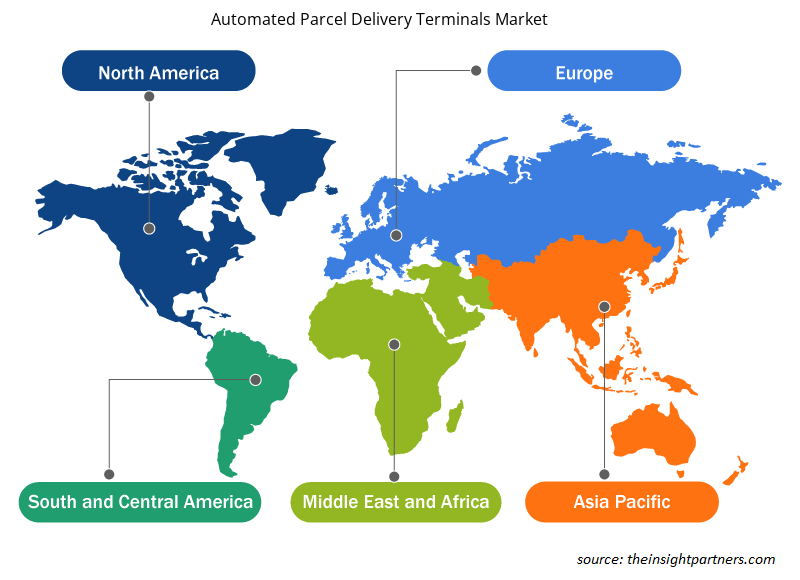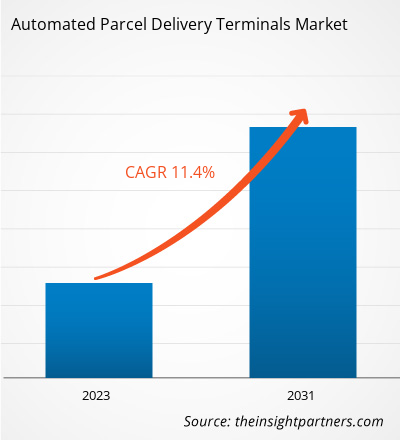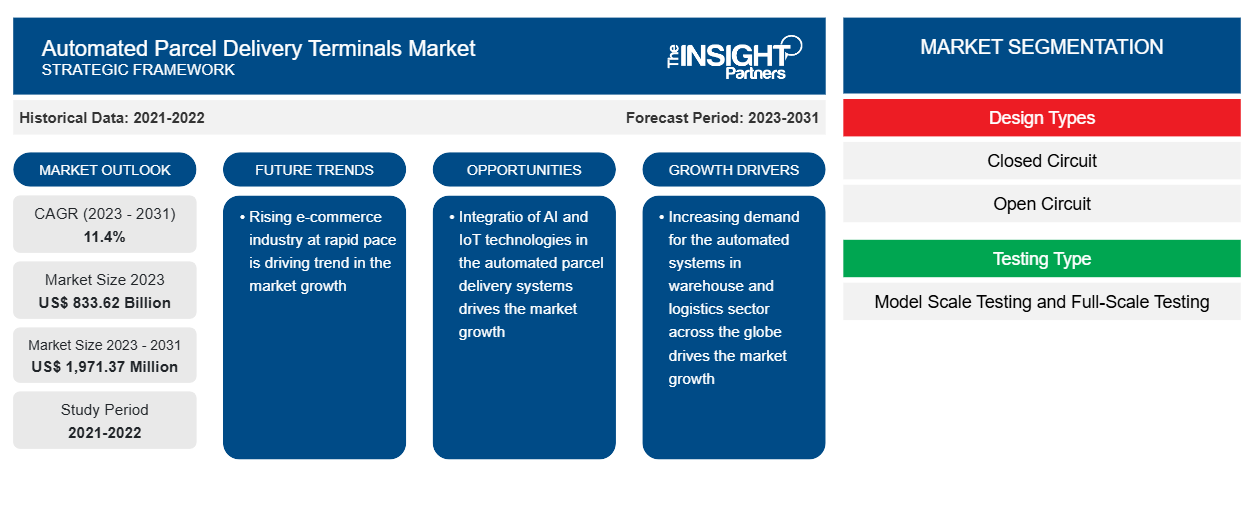Se proyecta que el tamaño del mercado de terminales de entrega automatizada de paquetes alcance los 1.971,37 millones de dólares estadounidenses para 2031, desde los 833.620 millones de dólares estadounidenses en 2023. Se espera que el mercado registre una CAGR del 11,4% en 2022-2031. Las terminales de entrega automatizada de paquetes son las taquillas automatizadas con unidades de autoservicio diseñadas para agilizar las entregas de paquetes. Estas terminales se instalan en lugares de mucho tráfico, como centros comerciales, tiendas minoristas, supermercados, paradas de autobús, aeropuertos, estaciones de tren y otras áreas públicas. El objetivo principal de estas terminales de entrega de paquetes es proporcionar una forma segura y conveniente para que las personas dejen y recojan paquetes en cualquier momento. Las terminales de entrega automatizada de paquetes se combinan con tecnologías avanzadas diseñadas para satisfacer la creciente demanda del sector de logística y almacenamiento.
Análisis del mercado de terminales de entrega automatizada de paquetes
El mercado de terminales de entrega automatizada de paquetes está creciendo rápidamente debido a la creciente demanda de los consumidores de opciones de entrega convenientes y sin contacto. El avance tecnológico para mejorar la productividad y el tiempo de entrega al consumidor ha generado una demanda significativa de crecimiento del mercado de terminales de entrega automatizada de paquetes. Las tecnologías avanzadas incluyen la integración de IA e IoT para automatizar las opciones de entrega de paquetes. Los actores clave en el mercado se están centrando en innovaciones tecnológicas para resolver problemas relacionados con la entrega de última milla. El crecimiento de la industria del comercio electrónico a un ritmo acelerado con el aumento de las tendencias de compras en línea creó una demanda masiva de crecimiento del mercado de terminales de entrega automatizada de paquetes durante el período de pronóstico.
Descripción general del mercado de terminales de entrega automatizada de paquetes
El creciente crecimiento de la industria del comercio electrónico con el aumento de las compras en línea entre los consumidores de todo el mundo ha creado una demanda masiva de crecimiento del mercado de terminales de entrega de paquetes automatizados durante el período de pronóstico. Según la Organización de Administración de Comercio Internacional, se espera que las ventas globales de comercio electrónico de las empresas B2B alcancen un valor de US$ 36 billones para 2026. Esto está impulsado por industrias pesadas como la fabricación, la atención médica, la energía y los segmentos de servicios comerciales profesionales que impulsan la mayor parte del crecimiento del mercado. La creciente demanda de sistemas automatizados en el sector de almacenamiento y logística en todo el mundo impulsa el crecimiento del mercado.
Personalice este informe según sus necesidades
Obtendrá personalización en cualquier informe, sin cargo, incluidas partes de este informe o análisis a nivel de país, paquete de datos de Excel, así como también grandes ofertas y descuentos para empresas emergentes y universidades.
-
Obtenga las principales tendencias clave del mercado de este informe.Esta muestra GRATUITA incluirá análisis de datos, desde tendencias del mercado hasta estimaciones y pronósticos.
Impulsores y oportunidades del mercado de terminales de entrega automatizada de paquetes
La creciente demanda de sistemas automatizados en el sector de almacenamiento y logística en todo el mundo impulsa el crecimiento del mercado.
El mercado está impulsado por el rápido crecimiento de la industria del comercio electrónico, que creó una demanda masiva de crecimiento del mercado de sistemas de entrega automatizada de paquetes. Esto ha impulsado el crecimiento del mercado de terminales de entrega automatizada de paquetes.
Además, factores como las entregas en zonas remotas y los intentos fallidos de entrega son responsables de generar costos adicionales para las empresas. Como resultado, las soluciones de auto-recogida como las terminales de entrega automatizadas de paquetes están ganando popularidad entre los minoristas de comercio electrónico.
La adopción mundial de teléfonos móviles y acceso a Internet ha hecho posible que los consumidores adquieran bienes de otros países. Se prevé que el número de envíos de paquetes aumente significativamente como resultado de ello. Los minoristas también están destacando el uso de opciones de entrega de paquetes alternativas para evitar entregas fallidas o demoradas.
Los gobiernos de todo el mundo están haciendo mucho hincapié en la digitalización y fomentando los pagos sin efectivo, en particular en países en desarrollo como China y la India. Los gobiernos pueden promover sus objetivos políticos de una economía digitalizada, sin efectivo y más transparente utilizando la opción de pago contra reembolso (COD) que se encuentra en las terminales de entrega de paquetes inteligentes, lo que facilita transacciones exitosas y sin problemas entre clientes y sus consumidores.
La creciente adopción de tecnologías avanzadas como el aprendizaje automático, la inteligencia artificial, la Internet de las cosas y la cadena de bloques están impulsando el crecimiento del mercado.
La creciente integración de tecnologías avanzadas como el aprendizaje automático, la inteligencia artificial y la Internet de las cosas para lanzar terminales de paquetería automatizadas está generando una oportunidad significativa en el mercado. Varios actores clave en el mercado están desarrollando y lanzando tecnologías avanzadas basadas en terminales de entrega de paquetería automatizadas. Por ejemplo, en noviembre de 2023, Oman Post, subsidiaria del Grupo Asyad, lanzó una innovadora máquina terminal de paquetería automatizada. La tecnología avanzada de vanguardia contribuyó a una mejora del 43% en la eficiencia operativa, lo que a su vez mejora la satisfacción del cliente. El sistema implementado con tecnología de IA para mejorar la productividad y aumenta la eficiencia de la entrega de paquetes a los clientes. Esta terminal basada en IA maneja hasta 6000 paquetes por hora y clasifica más de 12 líneas por tirada.
Análisis de segmentación del informe de mercado de terminales de entrega automatizada de paquetes
Los segmentos clave que contribuyeron a la derivación del análisis del mercado de terminales de entrega automatizada de paquetes son los proveedores de implementación y servicios.
- Según el despliegue, el mercado se divide en interior y exterior.
- Según los usuarios finales, el mercado se divide en minoristas/comercio electrónico, envío/logística, almacén, gobierno y otros.
Análisis de la cuota de mercado de terminales de entrega automatizada de paquetes por geografía
El alcance geográfico del informe de mercado de terminales de entrega automatizada de paquetes se divide principalmente en cinco regiones: América del Norte, Europa, Asia Pacífico, Medio Oriente y África, y América del Sur.
Se espera que América del Norte domine el crecimiento del mercado debido al rápido ritmo de adopción de tecnologías avanzadas basadas en terminales de entrega de paquetes automatizadas. Estados Unidos y Canadá tienen participaciones significativas en el mercado global, con una inversión cada vez mayor en automatización de almacenes por parte de las principales empresas de logística de Estados Unidos.
Sin embargo, existe una oportunidad significativa en los países en desarrollo de la región Asia Pacífico para adoptar terminales de entrega de paquetes automatizadas debido al mayor crecimiento de la industria del comercio electrónico en todo el mundo. India y China son los países que más rápido están adoptando terminales de entrega de paquetes automatizadas. Varios proveedores líderes de servicios logísticos están invirtiendo cantidades significativas en la adquisición de terminales de entrega de paquetes automatizadas para satisfacer la creciente demanda del sector logístico.
Perspectivas regionales del mercado de terminales de entrega automatizada de paquetes
Los analistas de Insight Partners han explicado detalladamente las tendencias y los factores regionales que influyen en el mercado de terminales de entrega automatizada de paquetes durante el período de pronóstico. Esta sección también analiza los segmentos y la geografía del mercado de terminales de entrega automatizada de paquetes en América del Norte, Europa, Asia Pacífico, Oriente Medio y África, y América del Sur y Central.

- Obtenga datos regionales específicos para el mercado de terminales de entrega automatizada de paquetes
Alcance del informe de mercado de terminales de entrega automatizada de paquetes
| Atributo del informe | Detalles |
|---|---|
| Tamaño del mercado en 2023 | US$ 833,62 mil millones |
| Tamaño del mercado en 2031 | US$ 1.971,37 millones |
| CAGR global (2023 - 2031) | 11,4% |
| Datos históricos | 2021-2022 |
| Período de pronóstico | 2023-2031 |
| Segmentos cubiertos |
Por tipos de diseño
|
| Regiones y países cubiertos |
América del norte
|
| Líderes del mercado y perfiles de empresas clave |
|
Densidad de actores del mercado: comprensión de su impacto en la dinámica empresarial
El mercado de terminales de entrega automatizada de paquetes está creciendo rápidamente, impulsado por la creciente demanda de los usuarios finales debido a factores como la evolución de las preferencias de los consumidores, los avances tecnológicos y una mayor conciencia de los beneficios del producto. A medida que aumenta la demanda, las empresas amplían sus ofertas, innovan para satisfacer las necesidades de los consumidores y aprovechan las tendencias emergentes, lo que impulsa aún más el crecimiento del mercado.
La densidad de actores del mercado se refiere a la distribución de las empresas o firmas que operan dentro de un mercado o industria en particular. Indica cuántos competidores (actores del mercado) están presentes en un espacio de mercado determinado en relación con su tamaño o valor total de mercado.
Las principales empresas que operan en el mercado de terminales de entrega automatizada de paquetes son:
- Soluciones de comercio electrónico Smartbox Pvt. Ltd.
- Cleveron AS
- Grupo NeoPost
- Compañía Industrial Winnsen, Ltd.
- TZ limitada
- ByBox Holdings Limited
Descargo de responsabilidad : Las empresas enumeradas anteriormente no están clasificadas en ningún orden particular.

- Obtenga una descripción general de los principales actores clave del mercado de terminales de entrega automatizada de paquetes
Noticias y desarrollos recientes del mercado de terminales de entrega automatizada de paquetes
El mercado de terminales de entrega automatizada de paquetes se evalúa mediante la recopilación de datos cualitativos y cuantitativos posteriores a la investigación primaria y secundaria, que incluye publicaciones corporativas importantes, datos de asociaciones y bases de datos. A continuación, se incluye una lista de los desarrollos en el mercado de terminales de entrega automatizada de paquetes y las estrategias:
- En abril de 2021, Cleveron, empresa de robótica para entrega de paquetes, lanzó el vehículo de entrega de última milla semiautónomo Cleveron 701. Está diseñado para mejorar la productividad y la eficiencia de las empresas de logística y minoristas para impulsar las entregas de última milla de los paquetes. (Fuente: Flyability, comunicado de prensa/sitio web de la empresa/boletín informativo)
Informe de mercado sobre terminales de entrega automatizada de paquetes: cobertura y resultados
El informe “Tamaño y pronóstico del mercado de terminales de entrega automatizada de paquetes (2021-2031)” proporciona un análisis detallado del mercado que cubre las siguientes áreas:
- Tamaño del mercado y pronóstico a nivel global, regional y nacional para todos los segmentos clave del mercado cubiertos bajo el alcance
- Dinámica del mercado, como impulsores, restricciones y oportunidades clave
- Principales tendencias futuras
- Análisis detallado de las cinco fuerzas de Porter
- Análisis del mercado global y regional que cubre las tendencias clave del mercado, los principales actores, las regulaciones y los desarrollos recientes del mercado.
- Análisis del panorama de la industria y de la competencia que abarca la concentración del mercado, el análisis de mapas de calor, los actores destacados y los desarrollos recientes
- Perfiles de empresas detallados con análisis FODA
- Análisis histórico (2 años), año base, pronóstico (7 años) con CAGR
- Análisis PEST y FODA
- Tamaño del mercado, valor/volumen: global, regional y nacional
- Industria y panorama competitivo
- Conjunto de datos de Excel
Informes recientes
Testimonios
Razón para comprar
- Toma de decisiones informada
- Comprensión de la dinámica del mercado
- Análisis competitivo
- Información sobre clientes
- Pronósticos del mercado
- Mitigación de riesgos
- Planificación estratégica
- Justificación de la inversión
- Identificación de mercados emergentes
- Mejora de las estrategias de marketing
- Impulso de la eficiencia operativa
- Alineación con las tendencias regulatorias























 Obtenga una muestra gratuita para - Mercado de terminales automatizadas de entrega de paquetes
Obtenga una muestra gratuita para - Mercado de terminales automatizadas de entrega de paquetes